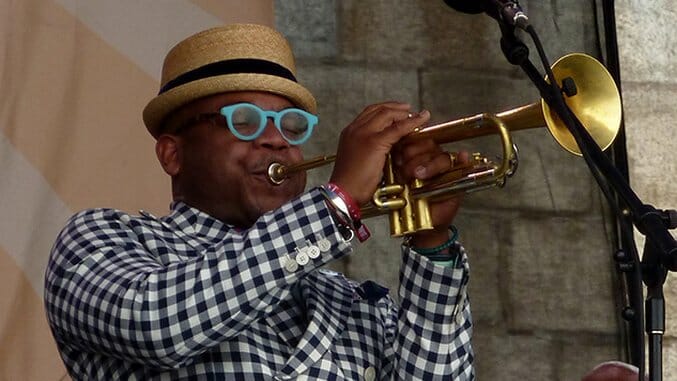Newport Jazz Festival 2016
Photo by Geoffrey Himes
The idea of Kamasi Washington is more interesting than his actual music. The idea of an instrumentalist reconnecting jazz to the popular black dance tunes of the day—which in our own time means hip-hop and funk—is immensely appealing. But his execution of that idea is underwhelming.
Washington is the most talked-about figure in jazz these days, so it’s not surprising that he was one of a handful of artists who were given more than one set at this past weekend’s Newport Jazz Festival in Rhode Island. And if he wasn’t quite able to realize his vision of reuniting jazz and popular music, there were several other artists who could.
Washington’s live show at Fort Adams State Park, looking out over the sailboat-dotted Narragansett Bay, revealed the same strengths and weaknesses as last year’s album The Epic. He displayed both a genuine talent and a flair for showmanship. The description of his tenor-sax sound as a cross between James Brown’s Maceo Parker and free-jazz’s Pharoah {cq} Sanders has some merit, and his two drummers and bassist were a powerhouse. And Washington’s band brought a visual flair to the proceedings; he himself wore a three-piece blue suit that included a shirt, pants and super-hero cape bordered with a gold pattern.
But the material was underwritten, and the borrowed funk elements never developed into mature harmonies. The piano playing was merely decorative, while the lyrics were new-age sloganeering and warbled in a thin soprano by Patrice Quinn. The attempts to compensate for the undernourished compositions with grandiose gestures backfired more often than not.
Does this mean that Washington’s ambitions are impossible to achieve? The Newport Jazz Festival provided multiple examples of how jazz can incorporate hip-hop and funk without lowering its standards.
Perhaps the best example came on Sunday from the Charles Lloyd Quartet. Lloyd may be a 78-year-old legend but half of his current quartet is made up of pianist Jason Moran and drummer Eric Harland, who both grew up on hip-hop in Houston in the ‘90s, and who incorporate that rhythmic vocabulary into everything they play. But they don’t merely regurgitate those beats unaltered; Moran and Harland transform those rhythms into something more elastic and unpredictable. They make it “the music of surprise,” which is one useful definition of jazz.
Bringing a full-bodied tone to both his tenor sax and his flute, Lloyd played long, elegant lines that sometimes locked into the rhythm section’s contemporary pulse and sometimes soared above it. On “Tagore,” Moran reached inside the piano to strum the strings like an autoharp, while Harland and bassist Reuben Rogers generated a stomping groove. Lloyd’s flute dipped in and out of that river of funk like a bird, demonstrating how jazz can make good use of contemporary pop without being constrained by it.
In similar fashion, the 33-year-old New Orleans trumpeter Christian Scott aTunde Adjuah began his set by tapping a laptop to trigger a repeating hip-hop loop on “Encryption.” But his drummer Corey Fonville wasn’t content to merely reinforce the loop; Fonville created counter rhythms that kept the beat interesting. Adjuah and flutist Elena Pinderhughes added lyrical solos that extended the possibilities of hip-hop far beyond anything on the radio.
-

-

-

-

-

-

-

-

-

-

-

-

-

-

-

-

-

-

-

-

-

-

-

-

-

-

-

-

-

-

-

-

-

-

-

-

-

-

-

-








































